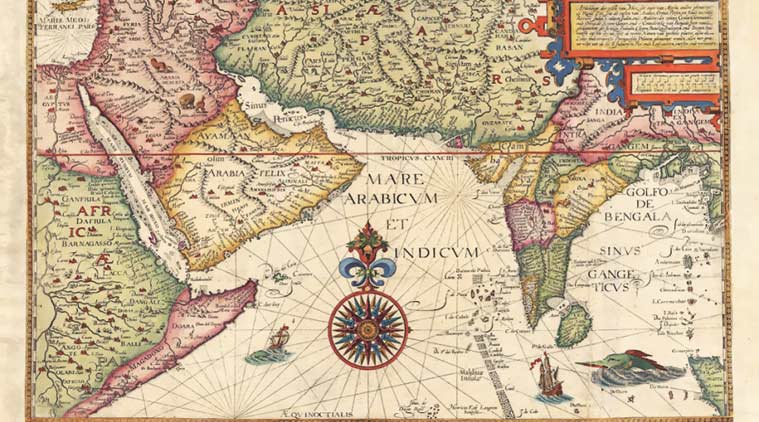Remapping the Past
National Museum’s latest exhibition gives a glimpse into rare Indian maps that shaped the perception of India over the centuries.
 India and the Middle East by Jan Huyghen van Linschoten Amsterdam, 1596, which is a copper engraving with and colour, 43.6 x 59.5 cm; Pichhvai of Vraj Yatra.
India and the Middle East by Jan Huyghen van Linschoten Amsterdam, 1596, which is a copper engraving with and colour, 43.6 x 59.5 cm; Pichhvai of Vraj Yatra.
An Indian map at Delhi’s National Museum dating back to the 19th century reveals the religious ceremonies that took place at the Jagannath temple in Puri. Created by hereditary chitrakaars associated with the temple, the images of Balabhadra, Subhadra and Jagannatha are housed within the iconic temple at the centre of the colourfully painted cloth frame. Also captured here are scenes from Puri’s vast kitchens — a few men carrying ritual offerings up to the steps and priests performing an aarti. Similar maps showcase Indian cartography’s epic journey — from mythological visions and religious depictions to the accurate scientific representation of India. The maps are a part of a two-month long exhibition titled “Cosmology to Cartography” at National Museum.
Seventy maps that are a part of the exhibition have been culled from the collection of Prshant Lahoti, founder of the Hyderabad-based Kalakriti Foundation. Lahoti’s interest in maps was sparked after he stepped into an antique map shop in Scotland in 2002 and was left intrigued . Thus began a journey to collect over 3,000 maps from across the world, making his collection the largest private collection of historic maps in India. “The maps in the archives have not been researched or preserved and are in danger of getting lost for the future generations. The whole idea of putting together this exhibition is to make more people develop an interest in maps. So the next time they find a map in their house, they don’t just throw it away,”says Lahoti.
One of the maps in the collections is Pichhvai of Vraj Yatra, which depicts the route of the Vraj Yatra undertaken by the pilgrims each year. As devotees move in a clockwise direction around the city of Mathura, the Pichhvai depicts Krishna during a raas leela with the gopis, scenes from his life apart from Mount Govardhana and the birthplace of Radha. Another map by a Dutch merchant, trader and historian Jan Huyghen van Linschoten also forms a part of the exhibition. He served as the Portuguese Viceroy’s secretary in Goa in 1583 and later abused the trust given to him by the Viceroy, as he copied secret maps page by page. His book, Itinerario, published in 1596, graphically depicted detailed maps of voyages to India for the Europeans. Alex Johnson, one of the curators of the exhibition, says, “Linschoten’s map was based on stolen Portuguese manuscripts and helped in opening the navigational routes for the English and the Dutch. The East India Company could finally end the 16th century monopoly enjoyed by the Portuguese.”
Other highlights include a map of northern India, published in Istanbul in 1732, which was believed to be the first map of India to have been printed in the Islamic world and to have employed typography in Arabic characters. The exhibition also features cartographic depictions of the ancient European conception of the subcontinent alongside the first near accurate map of India made following the arrival of Vasco da Gama in 1498. “Indigenous mapping done through early medieval period draws heavily from our experiences with pilgrimage and religious places. This contrasts the European notions of mapping that had more to do with measuring, quantifying, tabulating and calculating,” says architectural historian Vivek Nanda, the other curator of the exhibition.
The exhibition is on display till October 11 at National Museum, Janpath





- 01
- 02
- 03
- 04
- 05























